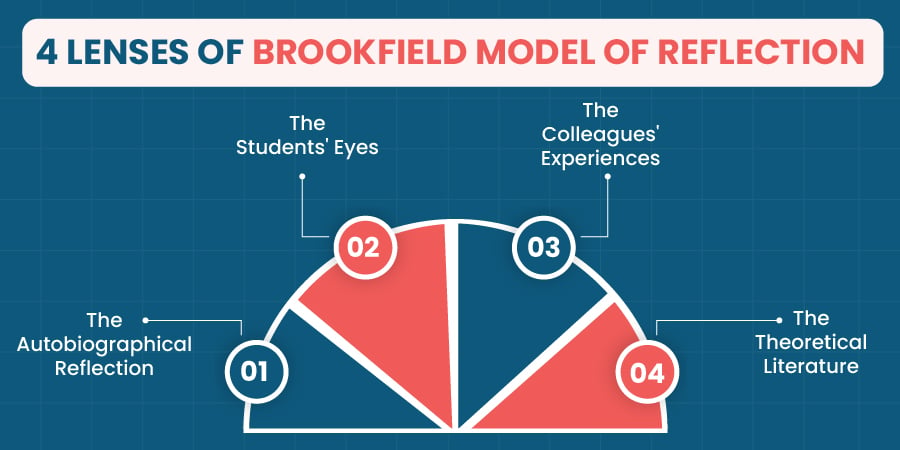A Step-by-Step Guide to Using Brookfields Reflective Model
Read and learn the four lenses of Brookfield reflective model from this informational write-up.
Read and learn the four lenses of Brookfield reflective model from this informational write-up.
Get A+ Within Your Budget!
Price Calculator
Offers & Benefits
Get upto 55% OFF on
Your First Order !






Table of Content
What Is the Brookfields Reflective Model Brookfield's Model of Reflection: Four LensesThe best way to learn from any mistake or event is self-reflection. For this, there are many reflective models that everyone can use to learn and improve. In this blog, you will learn about Brookfield's reflective model in depth. Moreover, you will learn about the various types of lenses that will help you understand the concept of reflection more clearly! So, let's not waste more time; dive into this informative blog to understand this method.
Before discussing what the Brookfields reflective model is, first, we should know about its developer, Stephen Brookfield, born in Liverpool, England, who initiated his teaching career in 1970. He has worked in multiple countries such as the United Kingdom, Canada, and the United States. He is an education specialist, he created a self-improvement model which is known as Brookfield's reflective model. It is a learning technique for teachers. But how is it different from the other reflection models? The speciality of this method is that it involves observing and reflecting on one's own experience. Moreover, it includes student's perspectives, which helps in better learning.
Get In Touch With UsNow that we know its developer, it's time to learn about the Brookfield reflective model in detail, including brookfields 4 lenses. It is a technique that aids teachers to reflect on their teaching methods, which improves their skills and assists in professional development. It is essential for teachers to reflect on their teaching. So, they can teach the concepts more effectively. Moreover, they can enhance their approach to evaluating, planning for tests, and designing or creating assessments. Thus, lets understand this model by learning about brookfield's four lenses.
According to Brookfield 1998 reflection model, reflection should be done on the basis of four different lenses, which he named the Brookfield lenses of reflection. Each lens has a different perspective, and all together will help you engage in the reflective practice for teaching. 
It is the first lens out of the four Brookfield lenses. This lens focuses on an individual's personal experience. In it, you will reflect on your personal experiences, perspectives, and assumptions. It is done to encourage self-awareness by investigating the impacts of your background, beliefs, and emotions on your actions.
Questions you can ask while using this approach:
As mentioned above, this reflection is different from the regular reflective models. In this model, it is essential to consider and understand the student's perspective. Analyzing the student's experience can assist you in identifying if there's a need to change your teaching approach.
Questions you can ask while using this approach:
Out of the brookfield 4 lenses, this one states that taking feedback and discussions with your peers or colleagues is very essential. Thus, taking feedback from your peers can help you understand the perspectives of your colleagues and how they react to certain situations. It will also boost your confidence as you will get to know that you are not the only one making mistakes.
Questions you should ask while using this approach:
Theories aid teachers in understanding and help them gain insights into that situation. According to Brookfield, a teacher should always be curious to learn more. While engaging with theories, try to relate all the other three lessons with them. Moreover, it will help you identify how you can apply your knowledge in real life.
Questions you should ask while using this approach:
So, these were the brookfields lenses of reflection. However, if you still have any doubt about this model, you can seek assignment help UK. They have experts who can help you understand this model better.
Brookfield's reflective model is a very useful tool for teachers to improve their teaching styles. However, every model has two sides, pros and cons. In this section, we are going to discuss the advantages and disadvantages Brookfield's reflective model.
Brookfields model of reflection is a very useful tool for teachers to improve their teaching styles. However, every model has two sides, pros and cons. In this section, we are going to discuss the advantages and disadvantages of Brookfield's reflective model.
Using this model and its lenses is challenging, but you can learn it by reading the brookfield's reflective model examples. By reading it, teachers can have a better understanding of their strengths and weaknesses. Thus, this leads to improvement in their teaching and professional growth.
Always note down the experience after a lesson. Whether it is positive or negative, jot it down. So, if the experience was negative, you can resolve the issue by applying different techniques. So, you can innovate your teaching style.
When you use Brookfield's 4 lenses, it will ensure a positive review from every student. Moreover, students will have a better understanding of what is being taught in class. In addition, you can identify which teaching style is more effective for students.
A good teacher has a great bond with their students. Using this reflective practice, you can understand your students better. Thus, it will enhance and boost your relationship with them.
So, these were the advantages of the reflective model. Now, let's jump to the next section and know the disadvantages of this model.
After discussing the brookfield's critical lenses and pros of this model. Now its time to discuss the coms of this model, So, let's discuss them now.
The process of identifying your mistakes is not as smooth as it seems; you need critical thinking and problem-solving skills. So, it can be quite challenging for some teachers.
The method causes confusion about which point or aspect you should focus on to reflect on. You have to approach every situation with different methods to use in a specific situation, which may lead to confusion among some teachers.
It is a very effective technique, but it is also a time-consuming process. Incorporating feedback, changing the process of teaching, identifying your mistakes, and more can take time if you are not aware of them since your initial stage of teaching.
So, these were the advantages and disadvantages of Brook's reflective model. Hopefully, you might have understood them well, even if you have any issues here, you can ask our writers, “can you do my assignment for me?” for an effortless experience. Also, you can search for brookfield reflective model example, it can help you in understanding it more clearly. So, now it's time to move to the next section, where we will be reading an example by experts to understand this reflective model properly.
As discussed above, Brookfield reflective model focuses on teacher's experience for adopting to digital tools in today's world. So, now to understand it in a better way, we have brought an example written by our expert. Thus, go through the below paragraph for understanding it in a better manner.
LENS 1
After the outbreak of Covid-19, there was a huge shift of traditional method of learning to new digitalized way. This new shift was very new for me at first. But eventually I adopted to these tools and got to know that they are actually effective for the students.
LENS 2
But when I took feedback from some of the students of my class, I got to know that a few of them believe that online learning is not productive for them and it lacks interaction..
LENS 3
For further clarification on this, I consulted few of my colleagues as well for their perspectives. They suggested me few teaching techniques like kinesthetic learning for students for enhancing overall result of the students..
LENS 4
After analysing all the possibilities, I came to the conclusion that kinesthetic style of learning is the solution. It helps one in personal growth and success and improve overall learning. It also helps in improving communication skills among students..
So, the above example must have helped you to understand the way educators can reflect upon their teaching method using the four lenses. You must read the above example properly for understanding this reflective model and its working. However, if you still have any issues regarding this, then worry not, we are here for your assistance. You can hire our assignment helper in the following manner.

Get an Extra 5% OFF On Your Order in Our App

Scan the QR code with your mobile to unlock an exclusive offer!
Download App Now
Hopefully, this blog has helped you in understanding Brookfield's reflective model and 4 types of lenses. However, if you still have confusion about this model, you can get one-on-one assistance; you can get assignment help in the UK from our experts. Our professionals have experience of more than a decade in providing top-quality services. Moreover, we at Assignment Desk provide you free tools such as a plagiarism checker UK and a paraphrasing tool, which will ensure you submit top-notch academic work. So, what are you waiting for? Contact our experts and kick out the stress of finishing your academic task.
While applying this model, try to put yourself in your student's shoes and review the situation from their perspective. Consider their reactions and what the impact of that situation was on them. Thus, using this approach can help you improving your teaching style.
Brookfield's reflective model is vital for reflection in teachers. This model can aid a teacher in enhancing self-awareness, improving practice, supporting collaborative learning, and ensuring their work is grounded in theory.
Being a critically reflective teacher is very crucial, as it is essential for professional growth. Here are a few tips that you can add to your teaching style using Brookfield's reflective model.
1.Align your teaching with desired student outcomes.
2.Engage learners by using multiple teaching styles.
3.Model critical thinking for your students.
Critical thinking is a crucial element of any reflective model. Likewise, Brookfield has its own thinking pillars, which are:
1.Foundation.
2.Process
3.Improvement
4.Application
Limited Time Offer
Exclusive Library Membership + FREE Wallet Balance
1 Month Access !
5000 Student Samples
+10,000 Answers by Experts
Get $300 Now
Update your Number
